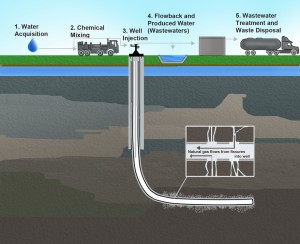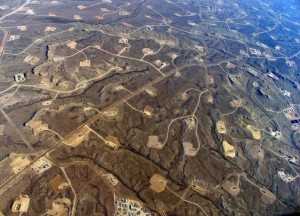From an Article by Renee Cho, Earth Institute, Columbia University, January 28, 2020
Over the last 10 years, the U.S. has become the largest oil and gas producer in the world, largely due to hydraulic fracturing, or fracking. From 2005 to 2018, U.S. natural gas production rose by 70 percent, and greenhouse gas emissions rose accordingly; between 2016 and 2018 alone, greenhouse gas emissions from US petroleum and natural gas production increased 13 percent.
But this increase in greenhouse gas emissions is headed in the wrong direction, since this year countries around the world will revisit the Paris Climate Accord to ramp up their pledges to reduce carbon emissions. This year 2020 might also install a new President in the White House — perhaps one who seeks to limit or ban fracking. Could this year determine fracking’s fate?
Fracking has always been controversial. Those supporting it cite the benefits of lower energy prices, job creation and energy security; those against it raise issues about negative environmental and health effects, and methane leaks, which contribute to global warming. An online poll found 48 percent of Americans in favor of fracking and 52 percent against.
The “benefits” of fracking: oil, natural gas & NGL
The “fracking revolution” has enabled the US to become the world’s supplier of most of the new oil produced since 2008 and end OPEC’s control over oil prices. As a result, fracking has increased energy security and lowered energy prices in the US. The fracking boom also strengthened the economy. A 2015 study found that a fracking-driven expansion in US oil and gas production added 725,000 jobs between 2005 and 2012; it also spurred manufacturing of equipment and demand for raw materials such as steel.
Some contend that natural gas is key to fighting climate change because it produces about half the greenhouse gas emissions that coal does per unit of energy. Natural gas has now replaced coal as the main source for generating electricity. The International Energy Agency estimated that since 2010, the substitution of gas for coal has saved 550 million tons of CO2 emissions globally. This switch has also resulted in less air pollution.
Natural gas has helped renewable energy use double since 2008. Romany Webb, who studies climate and energy at the Earth Institute’s Sabin Center for Climate Change Law, said, “The key benefit of the surge in natural gas-fired generation is it is a lot more flexible, so it’s a lot easier to use with intermittent renewables that come in and out—it’s a backup resource to ramp up and down to meet demand when the wind’s not blowing or the sun’s not shining.”
Under the Trump administration, permits to drill on public land have increased 300 percent. In 2019, Department of Interior revenues from leasing public lands to oil and gas companies and collecting royalties reached $12 billion, double the amount in 2016. These revenues get disbursed back to the federal treasury, the states and American Indian tribes and mineral owners to fund schools, public services and other projects.
The many downsides of fracking
1. Public Health & Occupational Health Issues
There is increasing evidence that fracking can potentially harm health. A 2019 report by the Concerned Health Professionals of New York and Physicians for Social Responsibility reviewed numerous studies on fracking’s impacts: 69 percent of water quality studies found the potential for water contamination, 87 percent of air quality studies found significant air pollution, and 84 percent of studies on human health risks found signs of harm or potential harm.
The water used for fracking is mixed with a variety of chemicals, some of which are carcinogenic or toxic; companies usually refuse to identify the chemicals, claiming they are trade secrets. If well casings crack, these chemicals can seep out and potentially contaminate aquifers and drinking water supplies, exposing local residents to toxins.
A 2016 study by Beizhan Yan and Steven Chillrud, geochemists from Lamont-Doherty Earth Observatory at Columbia University’s Earth Institute, found chemical changes in drinking water near fracking sites. The substances they detected were not at hazardous levels, but the discovery suggested that fracking could potentially cause groundwater contamination.
Once natural gas flows to the surface, the water that was used to frack—containing chemicals, salt and radioactive materials that occur naturally in shale—returns to the surface too. This wastewater, also called brine, often contains high levels of radium, which is exposing oil and gas workers and truck drivers who handle the brine and waste materials, and potentially the public, to carcinogens.
An investigation (soon to be published as a book) by science journalist Justin Nobel into oil and gas radioactivity found numerous cases of cancer linked to radioactivity in Louisiana’s conventional oil and gas industry.
A 2017 University of Chicago study determined that babies born within a half-mile of fracking sites were 25 percent more likely to be born at a low birth weight, making them more vulnerable to infant mortality, ADHD, asthma and learning problems. Researchers do not know if the cause is air or water pollution, chemical exposure or pollution from increased traffic.
A 2019 study of the effects of the shale gas boom in the Appalachians in the early 2000s found that air pollution resulted in 1,200 to 4,600 premature deaths. And in December 2019, a spike of rare Ewing sarcoma cases in teens and young adults in two heavily fracked counties in southwest Pennsylvania has prompted an investigation by the CDC and the state of Pennsylvania.
See Part 2, scheduled for tomorrow, for a continuation of this Article.



{ 1 comment… read it below or add one }
I sure hope part two is going to correct the impression left here,
that gas has reduced the US’ greenhouse gas impact.
Mary Wildfire, Roane County, WV